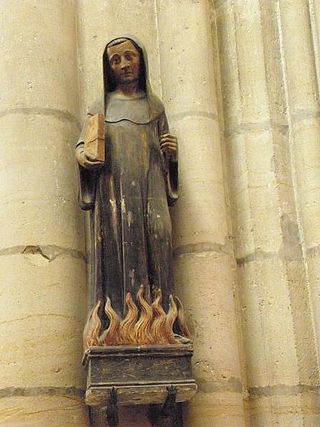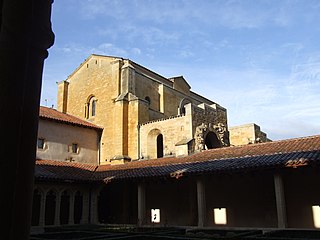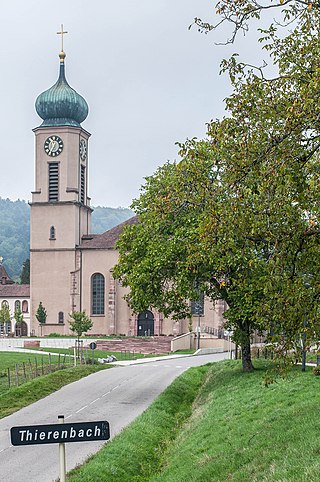This article needs additional citations for verification .(October 2021) |

In the Middle Ages, from the 11th century, the Cluniac order established a number of religious houses in the kingdoms of England and Scotland.
This article needs additional citations for verification .(October 2021) |

In the Middle Ages, from the 11th century, the Cluniac order established a number of religious houses in the kingdoms of England and Scotland.
Traditionally the Rule of Saint Benedict was interpreted that each monastery should be independent of other houses; this made it problematic to achieve reform if discipline had slipped or to resist the pressure to become a part of the Feudal structure, with the office of Abbot becoming an office at the disposal of the local lord. The Cluniac reform, the first major attempt to offer an institutional response to these issues, was to subvert this by making all of the monks of the houses that were part of Cluny members of the Cluny Abbey, with the subordinate houses being Priories of the Abbey. Subsequent orders – such as the Carthusians – were wholly integrated as an order, and modern Benedictines are organised in families which offer mutual accountability, e.g. the English Benedictine Congregation and the Subiaco Cassinese Congregation. Within just a century after its foundation the priory of Monk Bretton in Yorkshire ceased to be a Cluniac house, and remained Benedictine, pure and simple, till the Dissolution. [1]
Those houses that were larger than cells were known as priories, symbolising their subordination to the Abbey of Cluny in Burgundy. The prior of St Pancras at Lewes usually held the position of vicar-general of the Abbot of Cluny for England and Scotland. Since the head of their order was the Abbot at Cluny, all members of the order in Britain were bound to cross to France to visit Cluny to consult or be consulted, unless the Abbot chose to come to Britain. This he did five times in the 13th century, and only twice in the 14th.
In 1056, the first Cluniac nunnery was founded at Marcigny and after this other convents followed including those in the British Isles. The Cluniac nuns were always greatly outnumbered by their male counterparts.
In England, the Cluniac houses numbered thirty-five at the time of Henry VIII's Dissolution of the Monasteries in the 16th century. At that time there were also three houses in the kingdom of Scotland.

An abbey is a type of monastery used by members of a religious order under the governance of an abbot or abbess. Abbeys provide a complex of buildings and land for religious activities, work, and housing of Christian monks and nuns.

The Benedictines, officially the Order of Saint Benedict, are a monastic religious order of the Catholic Church following the Rule of Saint Benedict. They are also sometimes called the Black Monks, in reference to the colour of their religious habits. They were founded by Benedict of Nursia, a 6th-century monk who laid the foundations of Benedictine monasticism through the formulation of his Rule of Saint Benedict.

A priory is a monastery of men or women under religious vows that is headed by a prior or prioress. Priories may be houses of mendicant friars or nuns, or monasteries of monks or nuns. Houses of canons regular and canonesses regular also use this term, the alternative being "canonry".

Castle Acre Priory was a Cluniac priory in the village of Castle Acre, Norfolk, England, dedicated to St Mary, St Peter, and St Paul. It is thought to have been founded in 1089 by William de Warenne, 2nd Earl of Surrey. The order originated from Burgundy. Originally the priory was sited within the walls of Castle Acre Castle, but this proved too small and inconvenient for the monks; hence, the priory was relocated to the present site in the castle grounds about one year later.

The Tironensian Order or the Order of Tiron was a medieval monastic order named after the location of the mother abbey in the woods of Thiron-Gardais in Perche, some 35 miles west of Chartres in France). They were popularly called "Grey Monks" because of their grey robes, which their spiritual cousins, the monks of Savigny, also wore.
Gundred or Gundreda was the Flemish-born wife of an early Norman baron, William de Warenne, 1st Earl of Surrey. She and her husband established Lewes Priory in Sussex.

Cluny Abbey is a former Benedictine monastery in Cluny, Saône-et-Loire, France. It was dedicated to Saint Peter.
The Cluniac Reforms were a series of changes within medieval monasticism of the Western Church focused on restoring the traditional monastic life, encouraging art, and caring for the poor. The movement began within the Benedictine order at Cluny Abbey, founded in 910 by William I, Duke of Aquitaine (875–918). The reforms were largely carried out by Saint Odo and spread throughout France, into England, and through much of Italy and Spain.

The English Benedictine Congregation (EBC) unites autonomous Roman Catholic Benedictine communities of monks and nuns and is technically the oldest of the nineteen congregations that are affiliated in the Benedictine Confederation.

Arthington Priory was an English monastery which was home to a community of nuns in Arthington, West Yorkshire, founded in the mid-12th century. The priory land is occupied by a residence called "Arthington Hall", which was built around 1585, and little, if anything, remains of the priory. The site of the priory church is possibly now occupied by a farmhouse called The Nunnery. The community was the only one of nuns of the Cluniac congregation in Yorkshire and one of two in England. It was established through a grant by Peter de Arthington.

Thetford Priory is a Cluniac monastic house in Thetford, Norfolk, England. Founded in 1103 by Roger Bigod of Norfolk, Thetford was one of the most important monasteries of East Anglia.

Prior is an ecclesiastical title for a superior in some religious orders. The word is derived from the Latin for "earlier" or "first". Its earlier generic usage referred to any monastic superior. In abbeys, a prior would be lower in rank than the abbey's abbot or abbess.

Odilo of Cluny was the fifth Benedictine Abbot of Cluny, holding the post for around 54 years. During his tenure Cluny became the most important monastery in western Europe. Odilo actively worked to reform the monastic practices not only at Cluny, but at other Benedictine houses. He also promoted the Truce of God whereby military hostilities were temporarily suspended at certain times for ostensibly religious reasons. Odilo encouraged the formal practice of personal consecration to Mary. He established All Souls' Day in Cluny and its monasteries as the annual commemoration to pray for all the faithful departed. The practice was soon adopted throughout the whole Western church.
Majolus of Cluny was the fourth abbot of Cluny. Majolus was very active in reforming individual communities of monks and canons; first, as a personal commission, requested and authorized by the Emperor or other nobility. Later, he found it more effective to affiliate some of the foundations to the motherhouse at Cluny to lessen the likelihood of later relapse.

Lewes Priory is a part-demolished medieval Cluniac priory in Lewes, East Sussex in the United Kingdom. The ruins have been designated a Grade I listed building.

Charlieu Abbey or St. Fortunatus' Abbey, Charlieu was a Benedictine abbey located at Charlieu, Loire, Burgundy, France. It was later a Cluniac priory.

Montacute Priory was a Cluniac priory of the Benedictine order in Montacute, Somerset, England.

The Basilica of Our Lady of Thierenbach is a Cluniac priory and minor basilica located in Jungholtz, in the Alasace region of France.